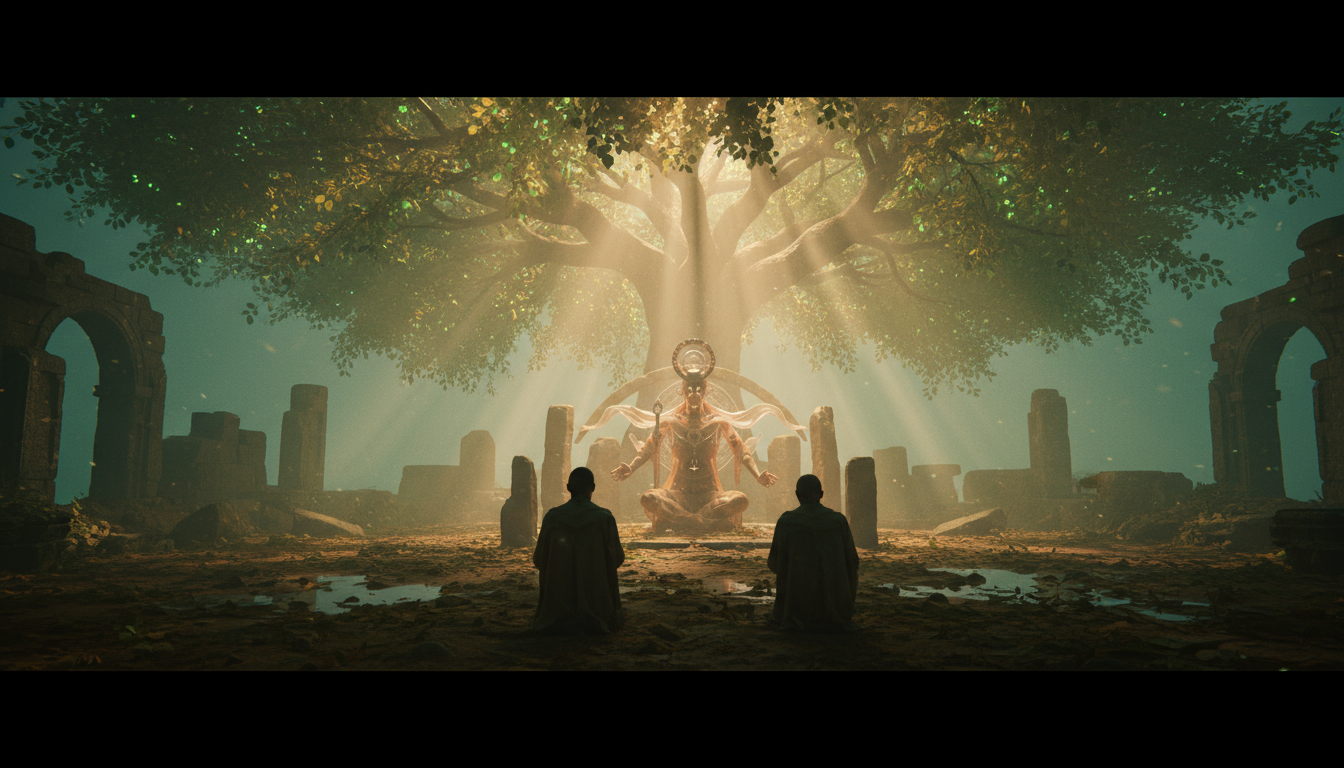The Breath Between Worlds

The first lesson a novice learns when entering the Scriptorium is silence. Before ink, before breath, before thought, there is the stillness from which all law is born. The elders call it Tovan, the Interval — the air between the Creator’s inhalation and exhalation, the pause where Moab’s intent took on shape.
We write this silence as Tovan Ki, yet even the words are an approximation. It is neither magic nor craft. It is the harmony that allows craft to exist, a filament woven through all living matter. Moab granted its spark to a select few among the children of the First Making — not as a reward, but as a test of balance. To wield it is to remember that the breath you take belongs partly to the world.
On the Origin of the Current
In the hymns of the Second Veil it is told:
“Moab set the rivers of life within the body of the world,
and from the confluence of these rivers arose sound.
Sound became breath, breath became will,
and will gave the form to power.”
Thus did the Current awaken. The Alfra name it Veledan, the “green pulse.” The Ida scholars call it Sophos Aeris — the wisdom of air. Yet all tongues agree on one symbol: a circle open at one edge, the mark of a breath never fully exhaled.
The first wielders did not summon Tovan Ki; they listened. Their art was receptive, not directive. A Maydaar warrior’s blade that hums with heat, a Dhukura gardener calling sap to heal a broken bough, an Ida healer closing a wound with mere touch — each is the same conversation between being and balance.
The Law of Reflection
Tovan Ki is bound by the Law of Reflection: whatever one gives the world, the world returns in equal rhythm. Force the Current through pride, and it recoils as entropy. Breathe with humility, and the Current amplifies your purpose.
The Order teaches three reflections:
- Ki of Motion — to move the seen world; fire, stone, and water.
- Ki of Echo — to align the unseen; thought, memory, and sound.
- Ki of Continuance — to mend the interval between life and death, matter and idea.
Few among the Ida reach the third. The Dhukura have walked closest, shaping forests into temples that breathe. Their gardens are said to bloom only in twilight because that is when the veil between breaths thins.
The Heresy of Shadwe
During the Great Mourning, when Baom’s light withdrew and Moab’s silence deepened, some among the First Wardens sought to command the Current rather than join it. Their failures birthed the Mopru. These beings did not break the law of reflection — they reversed it. Instead of offering breath, they consumed it. Their Ki became void, an anti-Current feeding upon decay.
The scholars of the Third Circle describe this corruption as the Mirror Unmade: where reflection should give likeness, it now gives absence. The Mopru call this absence freedom; the Scriptorium calls it hunger that cannot end.
On the Limitation of Flesh
Of every one million born across the continent, only one will carry the seed capable of awakening the Current. Many claim this is Moab’s cruelty. I contend it is mercy. Were all beings able to move the laws of nature by will, the harmony of worlds would collapse into discord.
The Dhukura’s oldest tablets warn:
“The forest that breathes in all tongues will drown itself in speech if each leaf demands a voice.”
Thus the gift is rare, so the world may remain articulate. The few chosen are not masters — they are interpreters translating between silence and storm.
Comparative Observation
In my own studies within Luvarel’s arboretum, I measured resonance between practitioners of different lineages. When an Ida adept of Anisi lineage invoked flame beside a Alfra Verdunesata of the Circle of Groves, the vibration doubled yet neither element overwhelmed the other. The sound harmonized into a tone approximating the First Chord described in the Moabite Canticles. The phenomenon suggests that all forms of Tovan Ki originate from a single root frequency — Moab’s initial breath — modulated through flesh, culture, and language.
Such harmonics may explain why Ida alone can traverse all aspects of Ki: their physiology and spirit were forged at the crossroads of Baom’s light and Moab’s life. In them, the breath finds full echo.
Ethics of Invocation
Every invocation must satisfy three precepts:
- Measure — Know the extent of the breath you borrow.
- Memory — Recall the silence that preceded it.
- Mercy — Return the world unharmed or made wiser.
To violate any of these is to fracture the circle. The fragments of that circle are seen in the wild zones of the Second Age, where misuse of Ki during the Veiled Reawakening birthed the shadowborn beasts catalogued in the Bestiary of Brovanthe. There, the corrupted Current mimics life but cannot sustain it, producing creatures whose existence is hunger shaped into motion.
Final Admonition
I have seen apprentices tremble at the threshold of awakening, fearing that to move the world is to challenge its maker. They misunderstand. To draw upon Tovan Ki is not rebellion but remembrance — the act of returning breath to its origin.
Moab did not forbid power; Moab forbade forgetting.
“The world inhales through us, and when we exhale rightly, the heavens breathe easier.”

